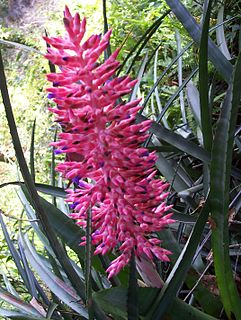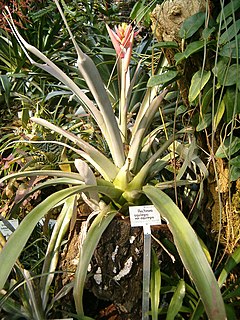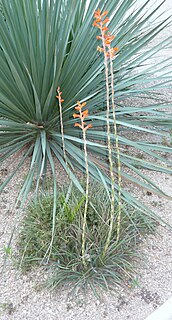
The Bromeliaceae is a family of monocot flowering plants of 75 genera and around 3590 known species native mainly to the tropical Americas, with several species found in the American subtropics and one in tropical west Africa, Pitcairnia feliciana.

Lupinus, commonly known as lupin, lupine, or regionally bluebonnet etc., is a genus of plants in the legume family Fabaceae. The genus includes over 199 species, with centers of diversity in North and South America. Smaller centers occur in North Africa and the Mediterranean. They are widely cultivated, both as a food source and as ornamental plants, but are invasive to some areas.

Vriesea is a genus of flowering plants in the botanical family Bromeliaceae, subfamily Tillandsioideae. The genus name is for Willem Hendrik de Vriese, Dutch botanist, physician (1806–1862). Its species are widespread over Mexico, Central America, South America and the West Indies.

Aechmea is a genus of flowering plants in the family Bromeliaceae. The name comes from the Greek aichme, meaning "spear". Aechmea comprises eight subgenera and around 250 species distributed from Mexico through South America and the Caribbean. Most of the species in this genus are epiphytes.

Canistrum is a genus of plants in the family Bromeliaceae, subfamily Bromelioideae.

Cryptanthus is a genus of flowering plants in the family Bromeliaceae, subfamily Bromelioideae. The genus name is from the Greek cryptos (hidden) and anthos (flower). The genus formerly had two recognized subgenera: the type subgenus and subgenus HoplocryptanthusMez which has been raised to the separate genus Hoplocryptanthus. All species of this genus are endemic to Brazil. The common name for any Cryptanthus is "Earth star".

Aechmea distichantha, the Brazilian vaseplant, or vase plant, is a bromeliad typical of Cerrado vegetation in Brazil, which is also native to northern Argentina, Bolivia, Paraguay, and Uruguay. This plant is often used as an ornamental plant.

Pitcairnia is a genus of plants in the family Bromeliaceae, subfamily Pitcairnioideae. It was named for William Pitcairn, Scottish physician and gardener (1711–1791). The genus Pitcairnia ranks as the second most prolific of the bromeliad family. They are most abundant in Colombia, Peru and Brazil, but can also be found in areas from Cuba and Mexico south to Argentina. One species, Pitcairnia feliciana, is found in tropical West Africa and is the only member of the family Bromeliaceae not native to the Americas.

Orthophytum is a genus in the plant family Bromeliaceae, subfamily Bromelioideae.

Pitcairnia subg. Pepinia is a subgenus of plants in the family Bromeliaceae. It has at times been treated as the separate genus Pepinia, but is now included again in the genus Pitcairnia. The name is for Pierre Denis Pépin, French member of the Imperial and Central Society of Agriculture (c.1802-1876).

Aechmea lamarchei is a plant species in the genus Aechmea. It is endemic to eastern Brazil, known only from the States of Minas Gerais and Espírito Santo.

Sincoraea heleniceae is a species of flowering plant in the family Bromeliaceae, native to Brazil. It was first described in 2004 as Orthophytum heleniceae.

Aechmea aquilega is a plant species in the genus Aechmea. This species is native to Brazil, Venezuela, the Guianas, Trinidad, Jamaica and Costa Rica.
Pitcairnia cuatrecasasiana, synonym Pepinia cuatrecasasiana, is a species of flowering plant in the family Bromeliaceae, native to Ecuador and Colombia. It was first described by Lyman Bradford Smith in 1942. The specific epithet is also spelt cuatrecasana.

Aechmea lingulata is a plant species in the genus Aechmea. This species is native to the West Indies, Costa Rica, Panama and northern South America.

Dyckia remotiflora is a plant species in the genus Dyckia. It is native to Argentina, Uruguay, and Brazil.

Sincoraea is a genus of flowering plant in the family Bromeliaceae, native to eastern Brazil. The genus was erected by Ernst Ule in 1908.
Marcos Henrique Louzada Silva, commonly known as Didi Louzada, is a Brazilian professional basketball player for the Cleveland Charge of the NBA G League. At the 2019 NBA draft, he was drafted by the Atlanta Hawks, before being traded to the New Orleans Pelicans.
Lapanthus is a genus of flowering plants belonging to the family Bromeliaceae.
Karawata is a genus of flowering plant in the family Bromeliaceae, native to eastern Brazil. The genus was first described in 2019.















